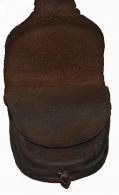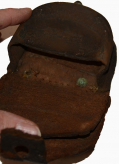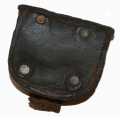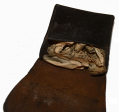site search
online catalog
IDENTIFIED WHITNEY NAVY REVOLVER OF FRANCIS B. BUTTS, AMONG THE LAST OFF THE MONITOR

$2,250.00 SOLD
Quantity Available: None
Item Code: 490-6782
US Navy Landsman Francis B. Butts was among the last men off the USS Monitor before the vessel sank off Cape Hatteras in December 1862. His account of the sinking is a thrilling and much-quoted primary source, originally published by the Soldiers and Sailors Historical Society of Rhode Island, as were some other of his reminiscences, and subsequently appeared in Volume 1 of Battles and Leaders of the Civil War, published by the Century Company.
This grouping comes with two string tags: one handwritten and the other typed. The handwritten tag is signed by “E.J. Chambers.” We have not identified him, but he was clearly a collector with an interest in firearms, listing the group as “Gun #271” and using what was likely his cost and source code, with the date. The main text of the tag reads: “Whitney Navy F.B. Butts w/ wood box + various items. Butts was last to leave the Monitor prior to sinking. #27299 on ramrod. P + JRG on cylinder.” The typed tag reads, “Whitney Revolver U.S. Navy Civil War carried by chief gunner’s mate Francis B. Butts The last man to leave the Monitor when she was towed under by the U.S.S. Frigate Rhode Island off Cape Hatteras.”
Chambers made a few errors: Butts was at the time a Landsman- a low ranking sailor- and he only claimed to be among the last to get off the ship, specifically naming a fellow sailor who ended up in a rescue boat next to him as the last man off the ship before it sank. Nevertheless, the tags clearly indicate the period when Chambers got the items and that the group belongs together and came from Butts or, more likely his family, since the sailor himself had died in 1905.
The group consists of four items: a US Navy inspected Whitney Navy revolver, a US Navy fuze box, and a cap box, all contained in a Victorian wood sewing box with key lock. The latter is about the size of a writing desk or bible box, made with attractive moldings, having a ledge inside to support a missing tray, with the underside of the lid lined with a padded fabric, and the lid held upright when open by a ribbon. The cap box is the standard configuration, unmarked, missing the belt loops, but with the rivets securing them still there, the inner flap with side-ears in place, and the cover showing wear and crackling with the tip of the latch tab missing, but the fastening stud in place. The fuze box is clearly marked on the outer flap: Navy Yard / New York / 1862. The latch tab is full length and in place, as is the fastening stud. The correct, single, wide belt loop is place on the reverse. The box is empty. The leather shows age crackling to the finish, but is very good.
The Whitney is a 2nd Model Type 4 and has serial number “27299 Y” visible on the loading lever with the “Y” being an assembly number. (We rely upon Williams, “The Whitney Navy Revolver” for details.) From 1863 through early 1865 the Army purchased some 10,587 of these .36 caliber revolvers and the Navy 6,224. As was common with navy revolvers this was given a tin finish to inhibit rust and corrosion. About 50-60 percent of this remains, showing gray in some areas, but brighter on the frame for instance, with scattered age spots or portions of exposed iron, and the hammer showing exposed blue. The barrel address is consequently weak, with just the upper portion of “E. WHITNEY” readily discernable. The cylinder has no visible scene, but Whitneys bear notoriously light cylinder scenes in any case. The wood grips are very good, with tight fit, good color and little wear.
The cylinder markings are very good: “P / JRG,” the inspection mark of John R. Goldsborough, who was on duty at the New York Navy Yard in the final months of 1864, after sea duty lasting to September 1864 and until reassignment to sea duty in November 1865 (See Daum and Pate, but note their typographical error in the dating.) Williams notes that USN inspection marks date mainly after an August 1864 directive, which accords with this revolver, which by their production dates (page 97) to later 1864. Their end number for the year is 28500, with an estimated 350 made per month, giving this one an estimate date of September or October, with Williams noting that the company was not necessarily operating on a first made-first shipped basis. On the other hand, those first inspection marks were to be an anchor on the barrel and a “P” over the inspector’s initials, but on the face of the cylinder and Williams thinks those on the side of the cylinder date to the “re-inspection” of revolvers at the conclusion of the war, which involved marking in that fashion revolvers that had not been previously marked but which were going to be retained in service. (p. 54-55.)
Butts thus clearly did not carry the pistol on or take it from the Monitor, especially given that he was lucky to get off the ship with just the wet clothes on his back, but it might agree with his full service record, which ran to April 23, 1865. Born in 1844, Butts (Francis Bannister Butts) was born in Providence, RI, and when war broke out was living in Cranston. He enlisted first in the army, mustering into Battery E, 1st R.I. Light Artillery as corporal on 9/30/61 and serving until discharged on 9/23/62 at Washington. During his time on the rolls the battery or portions of it saw action on the Peninsula at Yorktown, Williamsburg, and Malvern Hill, and then took part in Pope’s Virginia Campaign, fighting at Kettle Run, 2nd Bull Run, and Chantilly. Butts enlisted in the Navy just ten days after leaving the Army, enlisting 10/3/62 at Providence, R.I., for one year’s service, signing on as a Landsman, age 21, standing 5’ 9-1/4” with blue eyes, auburn hair and a “florid” complexion. He was posted first to the USS North Carolina, a receiving ship at New York, though October, then to the Washington Navy Yard to November, and then to the Monitor. After the sinking of the Monitor, he served on the Brandywine, a receiving ship at Baltimore, and then the USS Stepping Stones until discharge on 10/2/1863. He then enlisted in the Navy again, gaining an appointment on 1/25/64 as Pay Steward on the USS Flag and then as Pay Clerk on 3/13/65, serving in that position until discharge on 4/23/65, at which point he may well have gathered some souvenirs of his service. He was certainly proud of his military service, given the amount of writing he did about it, including the above cited articles and “My First Cruise at Sea and the Loss of the Iron-Clad Monitor” in volume 1, series 4 of the R.I. Soldiers and Sailors Historical Society personal accounts. We find him in 1880 living in Providence with wife and two children, and working as clerk for Internal Revenue. He died in 1905 in Cleveland, while Treasurer of the Madison Avenue Foundry Company, but was interred back in Providence. He was survived by his wife and at least one child, who likely retained these mementos. [sr][ph:L]
Extra shipping charge may be required.
DISCLAIMER: All firearms are sold as collector's items only - we do not accept responsibility as to the shooting safety or reliability of any antique firearm. All firearms are described as accurately as possible, given the restraints of a catalog listing length. We want satisfied customers & often "under" describe the weapons. Any city or state regulations regarding owning antique firearms are the responsibility of the purchaser. All firearms are "mechanically perfect" unless noted, but again, are NOT warranted as safe to fire!
~~~~~~~~~~~~~~~~~~~~~~~~~~~~~~~~~~~
THIS ITEM, AS WITH ALL OTHER ITEMS AVAILABLE ON OUR WEB SITE,
MAY BE PURCHASED THROUGH OUR LAYAWAY PROGRAM.
CLICK HERE FOR OUR POLICIES AND TERMS.
THANK YOU!
Inquire About IDENTIFIED WHITNEY NAVY REVOLVER OF FRANCIS B. BUTTS, AMONG THE LAST OFF THE MONITOR
For inquiries, please email us at [email protected]
Most Popular
Historical Firearms Stolen From The National Civil War Museum In Harrisburg, Pa »
Theft From Gravesite Of Gen. John Reynolds »
Selection Of Unframed Prints By Don Troiani »
Fine Condition Brass Infantry Bugle Insignia »
British Imported, Confederate Used Bayonet »
Piece Of Wood From The Room In The White House Where Lincoln Signed The Emancipation Proclamation »
featured item
WONDERFUL CONDITION ORIGINAL CONFEDERATE-MANUFACTURED KEPI FOR A DRUMMER BOY OR CHILD
This article of uniform clothing is an original, Civil War example of headgear manufactured in the Confederacy and presented here in wonderful, original intact condition. The period artifact is a small, dark blue colored, wool kepi, suited for a… (526-68). Learn More »
site search
Upcoming Events
The shop will remain closed to the public through Friday, Jan. 31st, re-opening on Saturday, Feb.… Learn More »



























